Database of luminescent minerals
wernerite
Chemical formula: See MEIONITE / (voir aussi/see also MARIALITE)
Family: Silicates
Status:
Crystal system : Tetragonal
Display mineral: OUI
Luminescence:
Longwave UV (365nm) colors: |
Yellow , Orangy yellow , | ||
Intensity LW:Very Strong | |||
Shortwave UV (254nm) colors: |
Yellowish , Pale Yellow , | ||
Intensity SW:Weak | |||
Daylight picture

Wernerite;
Grenville, Argenteuil Co., Qu�bec, Canada
Photo and Copyright:
Middleearthminerals.com
Used with permission of the author
Longwave (365nm) picture

Wernerite UVLW, Grenville, Argenteuil Co., Québec, Canada
Photo and Copyright: G. Barmarin
Shortwave (254nm) picture

Wernerite UVSW, Grenville, Argenteuil Co., Québec, Canada
Photo and Copyright: G. Barmarin
Pictures Galery:
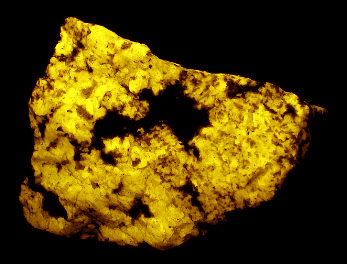
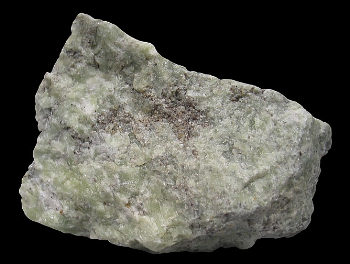
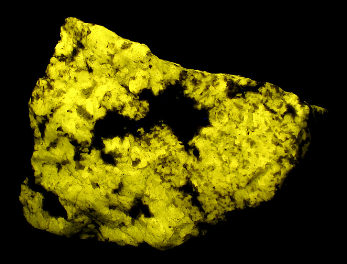
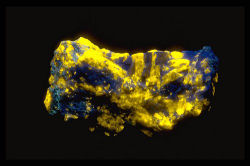 ...
...Do you have a photo of this mineral you would like to see in the gallery? Contact us!
Phosphorescence (in the common sense of the term) observable with the naked eye:
No data
Comments:
One of the most spectacular bright yellow luminescent mineral!
Activator(s) and spectrum:
Activator(s): S2-,
Peaks in the spectrum (nm):
(S2)- : Very broad band peaking around 600-603 nm with some waves superposed
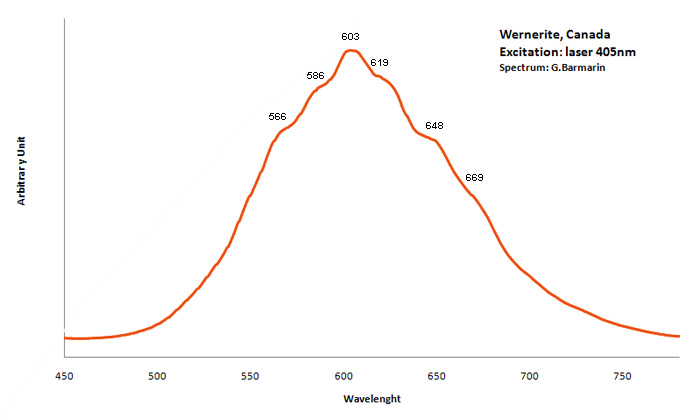
Col. G. Barmarin; Spectre: G. Barmarin
Spectrum Galery:
 ...
...Comments on spectrum and activators:
De Ment studied the fluorescence spectrum of wernerite in 1943. The emission spectrum is dependent upon excitation wavelength, indicating that S2- occupies several different sites. The luminescence emission spectrum is peculiar in that it is a series of distinct, nearly equally spaced bands, covering the region from 500 to 700nm with maximum intensity just below 600nm. This luminescence was originally attributed to 2+ UO 2 . Kirk (1954; 1955) showed that the luminescence center was more likely to be a polysulfide ion, S,, and later (Schulman and Kirk, 1964) deduced it to be S 2. Similar luminescence is found in hackmanite and in sodium thiosulfate reduced at 900 ° C. under UV light. The luminescence of wernerite can be enhanced by heating the samples to 900 °C for 24 h. (see Burgner R, Scheetz B, White W (1978) Vibrational structure of the S2- luminescence in scapolite. Phys Chem Miner 2:317–324).
Best localities for fluorescence (*):
- Otter Lake, Grenville, Quebec, Canada ;
- McGill Scapolite Prospect (Mc Gill Farm), Pointe-au-Chêne, Grenville-sur-la-Rouge, Argenteuil RCM, Laurentides, Québec, Canada ;
- Grenville Scapolite Prospect, Grenville-sur-la-Rouge, Argenteuil RCM, Laurentides, Québec, Canada ;
- Valyermo, California, USA ;
- Fort Coulonge Quebec, Canada (associated with blue sodalite, hauyne fl.orange LW and diopside fl.blue SW);
- Old St. Joe Mine in Edwards NY, USA (1969, associated with lazurite, phlogopite fl. yellow SW, hauyne fl. orange LW, diopside fl.skyblue SW);
- Autoroute 50 roadcut, Argenteuil County, Quebec, Canada ;
- Beluga sapphire property, Kimmirut (Lake Harbour), Baffin Island, Nunavut Territory, Canada ;
- Lady Smith, Pontiac RCM, Outaouais, Québec, Canada exploited by Darryl MacFarlane around 1996 ;
(*)The data are not exhaustive and are limited to a few remarkable localities for fluorescence
Bibliographic reference for luminescence:
- The Henkel Glossary of Fluorescent Minerals, Dr. Gerhard Henkel, Published by the FMS, 1989 ,
- Fluorescence: Gems and Minerals Under Ultraviolet Light, Manuel Robbins, 1994, Geoscience Press, ISBN 0-945005-13-X ,
- The World of Fluorescent Minerals, Stuart Schneider, Schiffer Publishing, 2006, ISBN 0-7643-2544-2 ,
- Handbook of Fluorescent Gems and Minerals, a practical guide for the gem and mineral collector, Jack de Ment, 1949 ,
Reference for luminescence on the Internet:
- Kirk, R.D.: Role of sulfur in the luminescence and coloration of some aluminosilicates. J. Electrochem. Soc. 101, 461–465 (1954)
- Kirk, R.D.: The luminescence and tenebrescence of natural and synthetic sodalite. Am. Mineral. 40, 22–31 (1955)
Images:
- Kimmirut, Canada: http://www.mindat.org/loc-192187.html
- Lady Smith, Quebec: http://www.mindat.org/photo-664090.html
- Mc Gill Farm, Quebec: http://www.mindat.org/photo-369900.html
Mineralogical reference on the Internet:
 http://www.mindat.org/show.php?name=Wernerite
http://www.mindat.org/show.php?name=Wernerite
 http://webmineral.com/data/Wernerite.shtml
http://webmineral.com/data/Wernerite.shtml
Internet Search:
 Image search on 'Google Images'
Image search on 'Google Images'
 Search for documents in all languages on Google
Search for documents in all languages on Google
A request providing no result means only that no such reference exists in the database, but it does not mean that what you are looking for does not exist, just not to our knowledge. If you think you have found an error or omission, please let us know via the contact page being sure to cite the source of information.

